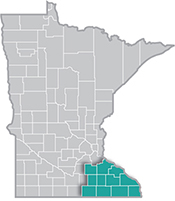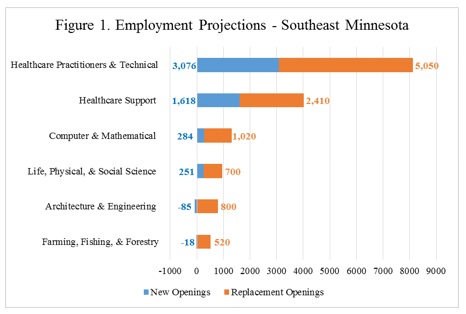 Southeast Minnesota is a health care and agricultural powerhouse. The region is home to the renowned Mayo Clinic and some of the world's most recognized food companies and brands.
Southeast Minnesota is a health care and agricultural powerhouse. The region is home to the renowned Mayo Clinic and some of the world's most recognized food companies and brands.
Advanced manufacturing is especially strong here, with machinery, chemicals, and electronics among the top products.
Want the freshest data delivered by email? Subscribe to our regional newsletters.
7/24/2017 9:47:04 AM
Innovation in Minnesota is increasingly important. Southeast Minnesota's innovative Mobile Science Lab Program recently received the Local Government Innovation Award (LGIA) as a Top Innovator for its traveling science lab. Instead of busing hundreds of students to post-secondary educational institutions for higher learning, this program brings "state-of-the-art scientific equipment" in a trailer to high schools to give students opportunities to explore careers in science and offers real-life experiences by allowing them to participate in science experiments in the classroom.
This program, which began in 2009, was originally planned to allow for growth in molecular biology in genomics in area high school classrooms. Expansions in agricultural bioscience occurred in 2011 and food science in 2012. In this program, high school science teachers attend the Mayo Clinic Educator Academy for an 'intensive' week-long training session and four additional meetings during the school year to encourage collaboration and review techniques. Over 145 teachers from over 50 school districts in the region participate.
"The lab is compact and its mobility is appealing," said Amy Grover, Southeast Service Cooperative. "So we're finding that teachers rent it two times a year for a week at a time. The predominant goal is to positively impact students' attitudes toward science education as well as their understanding of the relevance of science education for their future."
Data from surveys conducted after students complete the lab experiments show the program's impact. Over 90 percent indicated that the experience impacted them in a positive way, by increasing engagement in their learning, teaching them new skills, and/or increasing awareness of scientific careers. Students looked at 18 career paths, but three career fields stood out – health science (28 percent), STEM (24 percent), and agriculture/food science (17 percent).
In Southeast Minnesota, occupations in these groupings make up almost one-quarter (23.8) percent of all occupations, according to DEED's Occupational Employment Statistics (OES) data. A majority of these jobs are in health care, including 14.2 percent being health care practitioners and technical and another 4.9 percent in health care support. Four of these occupational groups are more highly concentrated in Southeast Minnesota than across the state as a whole, including life, physical and social science; health care practitioners and technical; health care support; and farming, fishing and forestry occupations (Table 1).

For these occupational groups, median wages ranged from $14.73 for farming, fishing and forestry to $40.68 for computer and mathematical occupations. In addition, four of the occupational groups have median wages significantly higher than those required to meet the basic cost of living needs, which currently rests at $15.52 for the typical family (two parents, one working full-time and one part-time, with one child) in the Southeast region, according to DEED's Cost of Living data. For the remaining two occupational groups that do not meet this threshold, the median wages are less than one dollar below.
Of the current 8,347 vacancies, 22.5 percent are in occupational groups related to the career fields that stood out among the surveyed students. As seen in Table 2, the majority of the vacancies in these groups are in the health care occupations, which is not surprising given that these same occupations account for the bulk of employment in these groups. Unfortunately, some of these occupational groups have moderate to high percentages of part-time vacancies, especially among health care support and farming, fishing, and forestry. However, very few are temporary or seasonal, including the two with the highest percent part-time, which offers some relief that at least many of the part-time openings will be year-round. For the most part, post-secondary education and experience are important for successful candidates to gain employment in these vacancies; however, for those occupational groups in which post-secondary education is not as relevant, the percentage requiring a certificate or license increases drastically.

While there is not projected to be growth in all of these occupational fields (architecture and engineering and farming, fishing and forestry are projected to lose jobs), overall there will be an increase in the total number of openings in all of the groups. Health care practitioners and technical, health care support, computer and mathematical, and life, physical and social sciences are all projected to see new openings, and all of the occupational areas are expected to need replacement hires. Again, the health care occupational categories see the largest change with a total of 12,230 openings, which is 76 percent of the total openings for these five areas and 16 percent of the openings across all occupations. In all, there is projected to be over 5,000 new openings and 10,500 replacement openings in the region from 2014 to 2024 in these categories.

Contact Mark Schultz.